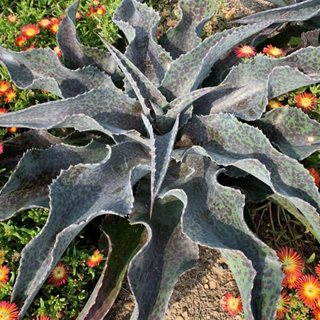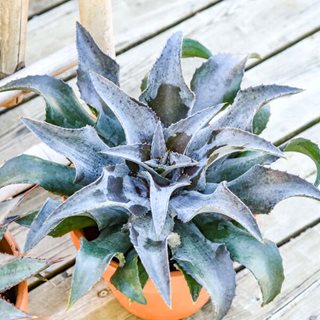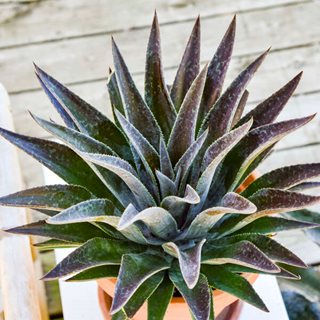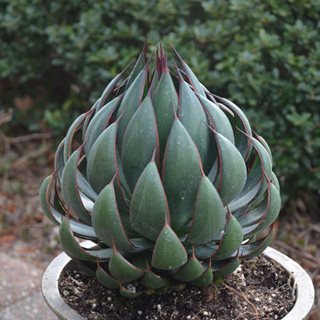How to Grow Magnificent Mangaves
If you love agaves, you’ll go mad for mangaves, an easy-care relative with spectacular foliage.If you garden in the desert Southwest, you are probably familiar with the agave plant, a drought-tolerant succulent admired for its dramatic architectural form. But you may not know about the latest succulent to rock the horticultural world—one that combines the shape and habit of Agave with the unique coloring of Manfreda, resulting in an intergeneric cross that boasts the best qualities of both.
Mangave (pronounced man-GAH-vay) is a showy newcomer that comes in an amazing array of colors, sizes, and growth habits, thanks to its hybrid parentage. Compared to plants in the Agave species, Mangave grow faster, can tolerate higher levels of moisture, and have softer, less prickly spines that make for easier handling. Many varieties also sport unique foliage features not commonly seen on Agave, such as attractive spotted patterns and wavy edges.
Although they are tender perennials, Mangave can be grown as annuals in colder climates or overwintered indoors as houseplants. Their bold, symmetrical form makes them ideal for use as striking stand-alone plants in containers and garden beds. Plus, they're deer and rabbit resistant, drought tolerant, and nearly maintenance free.
On this page: Basics | Planting | Care | Varieties | Frequently Asked Questions
BASICS
Botanical name:
x Mangave
Common names:
Mangave
Plant type:
Tender perennial (usually grown as an annual)
Zones:
9-11 for most varieties, with some hardy to zone 7
Exposure:
Full sun
Height/spread:
6 to 24 inches tall and 8 to 42 inches wide, depending on the variety
Foliage color and characteristics:
Arranged in rosettes, the leaves may be flat, wavy or curled, with an arching or upright habit. Foliage color runs the gamut from green to silver to lovely purple, red, and variegated forms, often with striking stripes or speckles.
Special attributes:
- More forgiving of overwatering than typical succulents
- Non-toxic and pet safe
- Deer and rabbit resistant
- Drought and heat tolerant
HOW TO PLANT MANGAVE
When to plant:
In spring, after the danger of frost has passed. Although Mangave can tolerate a light frost, they prefer temperatures that are consistently above 60 degrees F.
Where to plant:
For the most vibrant leaf color and spotting, plant in an area that receives full sunlight (at least 6 hours daily). At lower light levels, the color will fade but you can restore it by moving your plant to a bright, sunlit location.
Growing in containers:
Because of their diversity in shape and form, mangaves are well-suited for patio containers of all sizes and even hanging baskets, either alone or in combination with other succulents and annuals with similar moisture and exposure requirements.
When planting mangave alone in a container, use a well-draining soilless potting mix, such as a succulent and cactus mix, and a container just slightly wider than the width of the plant’s rosette. Make sure the pot has plenty of drainage holes to prevent soggy soil.
Pro Tip
"One of my favorite plants for pots is mangave! The structure gives the most interesting look to pots. And, if you combine it with a spiller, like Dichondra 'Silver Falls' or trailing ivy, it's a fantastic combination! Mangave can take more water than other succulent plants, so it's perfect in combinations that need more consistent watering." — Janey, of Dig, Plant, Water, Repeat
MANGAVE CARE
Watering:
One of the greatest attributes of the mangave plant is a tolerance for more water than other succulents (although extremely wet conditions should be avoided). Mangaves are drought tolerant once established, but young plants will appreciate watering during dry spells.
Fun fact: Regularly watering a mangave actually makes it grow faster! If you’re happy with the size of your mangave and want to slow its growth, simply water it more sparingly. This gives you the ability to regulate the size of your plant and keep it in proportion to its container.
Fertilizing:
During the active growing season (from spring through early fall) apply a fertilizer formulated for succulents, following the dosage instructions on the package. Mangaves are not heavy feeders and won’t benefit from overfertilizing. Withhold feeding during the winter months.
Pruning:
This low-maintenance plant needs no pruning or shaping to maintain its appearance. However, you should remove any browning or damaged foliage by cutting it off near the base of the leaf.
Pests and diseases:
Because of their thick, spiny leaves, mangaves are rarely bothered by insect pests or hungry critters like deer and rabbits. However, they can develop root rot if allowed to sit too long in overly wet soil.
MANGAVE VARIETIES
FREQUENTLY ASKED QUESTIONS
Is mangave cold hardy?
Most mangaves can survive temperatures as low as 20 to 30 degrees F, but plants should be protected or moved indoors if a hard frost is predicted.
Do mangaves flower?
Although mangaves are primarily grown for their foliage, older plants may flower when grown under ideal conditions, sending up tall spires of tubular yellow blossoms similar to those seen on agave plants. Once a plant blooms, it will usually die and leave behind small offsets, called "pups," that form around the base. These can be removed to propagate new plants or allowed to grow in place and replace the parent plant.
How do you take care of mangave in the winter?
In regions with cold winters, you should bring potted mangave plants indoors in early fall before temperatures consistently drop below 60 degrees F. In warmer climates where mangave can be overwintered outdoors, the biggest concern is overwatering. Be sure to let the soil dry out between waterings, since overly wet soil during the winter months can lead to root rot.
Can you grow mangave plants indoors?
Mangaves will do quite well indoors, as long as they receive enough sunlight and are kept at room temperatures above 60 degrees F. For the best color retention, give your plants at least 6 hours of light daily by placing them near a sunny window or under a grow light. During the winter months, when plants are semi-dormant, cut back on watering frequency (see 10 Tips for Keeping Houseplants Healthy in Winter).
















